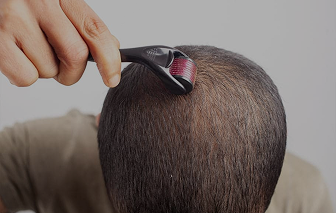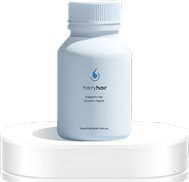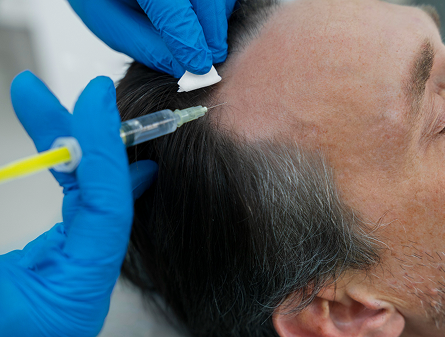Microneedling is a treatment that involves making tiny punctures in the top layer of the scalp known as the epidermis with very small needles. It is a minimally invasive treatment that can help to promote hair growth from dormant follicles.
Dutasteride is a treatment for androgenic alopecia that was originally used to treat enlarged prostates but can be prescribed off-label to treat hair loss. It is a dihydrotestosterone (DHT) blocker that helps to prevent the miniaturisation and shrinking of hair follicles.
Microneedling can be performed in a clinic or at home depending on the extent of the hair loss. Dutasteride must be prescribed and it is only approved as a hair loss treatment in Japan and South Korea so it may be hard to access. Explore the comparison table below to see if microneedling or dutasteride is the right treatment for you.
- Microneedling creates micro-injuries in the scalp to promote healing, collagen production, and hair regrowth.
- Unlike dutasteride, it works topically and doesn’t affect hormonal balance.
- Dutasteride is a prescription medication that blocks type I, II, and III 5-alpha reductase enzymes.
- Compared to microneedling, it treats hair loss internally by reducing DHT.
- Microneedling home-use tools cost around $30–$100; in-clinic sessions are pricier.
- Offers a low-cost entry point with some recurring needle replacement.
- Dutasteride costs approximately $40–$80 monthly and requires ongoing prescriptions.
- More expensive over time compared to microneedling, especially for long-term use.
- Microneedling is performed weekly or fortnightly, with results appearing within 3–6 months.
- It requires continuous effort and proper tool maintenance.
- Dutasteride is taken daily; most users see changes within 3–6 months.
- Unlike microneedling, it’s a low-effort, once-a-day routine.
- Microneedling is an external, physical method using a dermaroller or pen on the scalp.
- Encourages topical absorption and healing.
- Dutasteride is an oral medication that modifies hormonal levels.
- Compared to microneedling, it treats hair loss from within the body.
- Microneedling is generally safe but can cause redness or infection if tools aren’t properly sterilised.
- Fewer long-term risks than hormonal drugs.
- Dutasteride may lead to sexual side effects and hormonal imbalances in some users.
- Compared to microneedling, it requires more check-ups to ensure safety.
- Microneedling requires setup, sanitation, and aftercare, especially at home.
- Demands more attention than taking a pill.
- Dutasteride is easy to use—just one tablet per day.
- Unlike microneedling, there’s no preparation or physical handling involved.
- Microneedling tools are widely available online without a prescription.
- More accessible than dutasteride, especially for women.
- Dutasteride requires a prescription and is often used off-label for hair loss in Australia.
- Less accessible than microneedling due to medical regulations.
- Microneedling results are maintained with regular use.
- Results fade gradually if stopped for extended periods.
- Dutasteride sustains hair growth while taken, but hair loss resumes when discontinued.
- Compared to microneedling, results can reverse after stopping.
- Microneedling enhances the absorption of minoxidil and other topicals.
- Often paired with topical and oral treatments for a combination approach.
- Dutasteride can be combined with topical minoxidil or microneedling for a well-rounded treatment.
- Unlike microneedling, it targets internal causes while other treatments act externally.
- Microneedling appeals to users seeking a non-drug, hands-on method.
- Viewed as natural by stimulating the body’s healing properties.
- Dutasteride attracts users looking for robust, low-effort hormonal regulation.
- Compared to microneedling, it offers more convenience and less physical effort.
- Microneedling supports scalp health, boosts collagen, and improves skin texture.
- Offers cosmetic and dermatological benefits beyond hair growth.
- Dutasteride reduces DHT but has no direct impact on scalp health or skin.
- Unlike microneedling, it is limited to countering the effects of hormonal hair loss.
- Microneedling tools are reusable but create occasional waste from replacement heads.
- More sustainable than continuous medication packaging.
- Dutasteride produces consistent waste from monthly packaging and prescriptions.
- Compared to microneedling, it generates a more long-term environmental impact.
Shop our hair solutions
We are committed to providing affordable hair regeneration services for people all over Australia. Our formula can help you regain your confidence.
Shop Now

Microneedling vs Dutasteride Treatment Comparison Summary
Microneedling is a relatively new treatment in the dermatology field so further research may be required to see how effective it is to treat hair loss. Initial results from studies appear to be positive but it may need to be combined with another treatment like platelet-rich plasma (PRP) injections or a topical hair growth solution like minoxidil to be effective.
Dutasteride is a more potent DHT blocker than comparative medications like finasteride and results have been positive. It is recommended for people who have tried finasteride and have not seen results as it targets all three types of isoenzymes responsible for the conversion of testosterone into DHT while finasteride can only target two.
Microneedling sessions can be costly as they are required regularly at first and necessitate top-up sessions to maintain results. At-home devices can be purchased but may not work for more advanced forms of hair loss.
Dutasteride pills can range vastly in price and are typically more expensive than finasteride. This cost should be considered before beginning treatment as dutasteride is designed to be used on a long-term basis.
User Guidance
Microneedling may be suitable if you are looking for short-term results to recover hair in the early stage of hair loss. Dutasteride is better as a long-term treatment and consistency is key to achieving results as a certain amount of the chemical needs to be present in the body to see hair growth.
If the medication is stopped the hair growth gained will reverse. Microneedling can come with some minor side effects including redness, mild swelling, and flaking. If performed at home there is a risk of aggravating the scalp if the equipment is not properly disinfected and careless application can cause damage to the treatment area.
Dutasteride can have side effects relating to sexual function including a decreased libido, ejaculation issues, and impotence.
Take Our Hair Loss Quiz to See Which Treatment Suits You?
Take A Hair Quiz

Frequently Asked Questions
We have put some commonly asked questions.
Nunc scelerisque tincidunt elit. Vestibulum non mi ipsum. Cras pretium suscipit tellus sit amet aliquet. Vestibulum maximus lacinia massa nontor.
Platelet-rich plasma (PRP) treatment involves drawing blood from the patient, isolating the beneficial nutrients and injecting it into the scalp where hair loss is occurring. This promotes hair growth and has many other applications from encouraging healing to skin rejuvenation.
Platelet-rich plasma (PRP) treatment involves drawing blood from the patient, isolating the beneficial nutrients and injecting it into the scalp where hair loss is occurring. This promotes hair growth and has many other applications from encouraging healing to skin rejuvenation.
Platelet-rich plasma (PRP) treatment involves drawing blood from the patient, isolating the beneficial nutrients and injecting it into the scalp where hair loss is occurring. This promotes hair growth and has many other applications from encouraging healing to skin rejuvenation.







 See All
See All